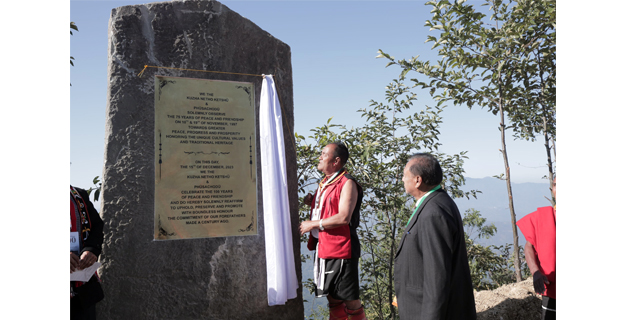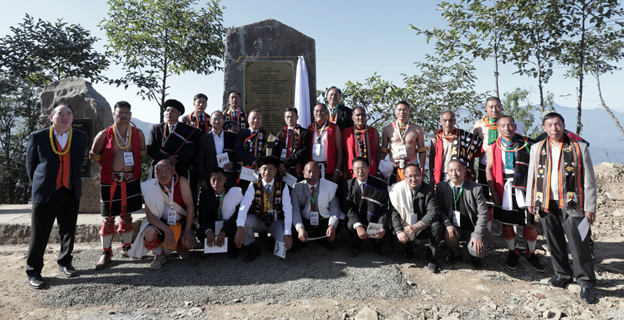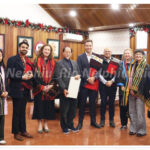Kohima, 16 December (MTNews): Phüsachodü village and Kuzha Netho Kethsü, comprising Leshemi, Lasumi, and Zapami villages under Phek district, reaffirmed their commitment to uphold, preserve, and promote the bond of friendship and oneness during their friendship centenary celebration at the local ground in Phüsachodü village on December 15.
Speaking on the occasion, Advisor for CAWD and Taxes Küdecho Khamo emphasized the need for Nagas to live together for peace and harmony. He urged the villagers to become ambassadors of unity and peace, setting an example for others to follow. Appreciating the pioneers for their farsighted vision and diplomacy in bringing the villages together for peace and friendship, he observed that many parts of the world grapple with war, calamities, hunger, and social unrest. “We are fortunate to have the blessings of unity, peace, and social harmony bestowed upon us by the grace of God,” said Khamo. He further encouraged everyone present to cherish, uphold, preserve, and promote this valued friendship of the four villages.
Kewekhape Therie, ex-minister, speaking on the occasion, said the celebration marks a significant milestone commemorating a century of enduring peace and friendship established by the ancestors. He hoped that the younger generation would imbibe the message of peace, unity, and friendship through the celebration. “This legacy must be preserved and passed on for generations to come,” he said.
The program was chaired by Murohu Chotso, Rtd, NCS, with an invocation by Rev Dr Dingu Kenye from Lasumi Baptist Church, a welcome address by VCC Phusachodu village, Vehupa Rose, and the release of a souvenir by Hütsonyi Chuzho, Rtd. PA to DC. Short speeches were delivered by Senowekha K Kenye, Rtd Director, Mikha Lomi, Rtd NCS, Dr. Chotisuh Sazo, ex-speaker, NLA. The closing prayer was offered by Rev Dr Chekrovei Cho-o, executive secretary, CBCC.

A monolith was erected marking the occasion, stating, “We, Kuzha Netho Ketshü & Phüsachodü, celebrated the 100 years of peace and friendship and hereby solemnly reaffirm to uphold, preserve, and promote with boundless honor the commitment of the forefathers made a century ago.”
Historical Context of Peace and Friendship
The Naga villages were historically individuated in terms of settlement, culture and socio- political systems. This made every Naga village a unique political entity. Looking back, there were warring villages traditionally engaged in headhunting. As a matter of fact, headhunting practice was a culture for the Naga villages and therefore, if not for offensive assaults, the villages used headhunting to defend their own villages. In some cases, dominant warrior villages protected smaller villages. Otherwise, the alliance of friendship-villages could become a dominant power bloc.
Also, a village enters peace treaty with a traditionally non-warring village in order to neutralise the threat from an opponent village as a measure of diplomacy or offense.
Prior to peace and friendship between Kuzha Netho Kethsü viz. Leshemi, Lasumi and Zapami, also referred to as Tsüromi, Tüphüzumi and Niezami by Phüsáchodümi, and Phüsachodü or Satshemi as referred by Kuzha Netho Kethsü, it might have been common practice for the warriors of both sides to kill and take away war trophy given any opportunity. However, going by the oral narratives of both sides, there was no-history of traditional enmity between the two entities. Elders from both sides remember how an unfortunate head-taking incident followed by retaliation had almost led to a full-fledged war between the two. Yet, the wise ancestors of both sides had chosen to make peace and friendship rather than bloodshed. As reported, a leader from Phüsachodü told his villagers to give a thought for peace with the Kuzha-Netho Kethsü. Accordingly, the Kuzha Netho Kethsü and Phüsachodü had entered into Thsüta/Züh-Wu Khrietho in the year 1923.

The peace and friendship between the two entities was a war-equated friendship and as a result, since the commencement of friendship between the two entities, it has been considered a respectable and honourable friendship trust. This friendship was originally forged between equals, worthy of allegiance, trust, strength and capabilities. Accordingly, the two entities had exchanged spears by pronouncing under oath not to lay harm on each other henceforth. The two entities had become a dominant alliance, not necessarily from an offensive approach but definitely as a defensive measure; and have remained each other’s most trusted ally and support. The peace and friendship had overcome the hatred and bloodshed to grow into the most valued and trusted friendship entities.
Both Phüsachodümi and Kuzha Netho Kethsü were once upon a time celebrated valiant warrior villages. The warriors went far and wide to hunt for trophies. While doing so, both the entities had bred their own enemies with many villages. Yet, the ancestors of both sides had fostered trusted friendships with a number of villages far and wide. As for Phüsachodümi friendship was made with Sapu Puchümi (Pudunamei of Manipur State in 1880), Chuzho Nasüh (Kuzha Netshü) in 1923, Chedemi (Kidima) in 1940 and Jakhama, and so on. And prior to the friendship with Phüsachodü, the Kuzha Netho Kethsü had made friendships with Dami (Kidima) in 1895 and Pfüchümi (Pudunamai) in 1903, and so on.
In the year 1997, the 75th Anniversary of Peace and Friendship was celebrated on 18th November at Phüsachodü, and the following day, the 19th of November at Zuketsa, the headquarter of Kuzha Netho Kethsü. During the same event, both sides reaffirmed their friendship and brotherhood. And in this memory a monolith stone each was erected at Phüsachodü and Zuketsa.
THSÜTA/ZÜH-WU KHRIETHO: A COMMITMENT OF THE HIGHEST ORDER
Politically speaking, and according to the Kuzha Netho Kethsü traditions, Thsüta is the highest level of peace-making, friendship and brotherhood process. Likewise, for Phüsachodümi, the Züh-Wu Khrietho is a friendship forged full-heartedly without any inhibitions; a commitment of the highest order with promises of alliance for any future wars, mutual physical and material help in times of disasters and adversities.
In the context of Kuzha Netho-kethsü, Thsüta can be explained as “upon an agreement to have reconciliation between the two entities, all the menfolk would visit each other’s village for Tsutal Züh-Wu Khrietho ceremony by taking oath of allegiance, exchanges spear and declare “tsüchyzülo zhimeci kelelepheh khimode”, which translates as “from this day onward we will not lay Iron/metal upon each other”. Alongside the ceremonious observances, the menfolk would search their bosom friend called Thrami or Khrietho, from each other’s village. This is done to strengthen the concord and bond of friendship among individuals as well as between the villages that had come into accord. Thsüta/Züh-Wu Khrietho holds a deeper meaning due to the active involvement and participation of individuals from both the communities. On the second day, recreational activities and competitions were held, and there were feastings to strengthen the bond. This is done to maintain peace and harmonious relationship with each other. This significant act is called Thsüta.
The concept of Züh-Wu Khrietho holds similar essence where both sides pledge to have no further enmity, and promise alliance in the event of war. The friendship between Phüsachodümi and Chüzho Nasüh/Kuzha Netho Kethsü is a Züh-Wu Khrietho which means ‘Bosom Friend’ (connoting an unconditional bond of friendship). This friendship is bonded by exchange of Thüyi Kükü (Cold Iron/metal) in the form of Spear or Dao after which it was taboo to raise/lay hands on each other; and in any accidental cases, fights between individuals or groups, ought to be forgiven in the name of friendship.
Some Thrami/Khrietho made during the celebrations as remembered till today are:
1. Suluhu Ruho: Senokha (Leshemi)
2. Hüda Khamo: Kamo (Leshemi)
3. Thüvonü Chuzho: Tsowödah (Leshemi)
4. Hüreyi Cürhah: Dikha Dekho Losou (Leshemi)
5. Deyiemo Chuzho: Pfuchukha Kreo (Zapami)
6. Zünüyi Khamo: Lhipenyi Sarah (Leshemi)
7. Nüthitso Chotso: Wezulhi Khupfu (Lasumi)
8. Mucheyi Sazo: Wezülhi Krome (Lasumi)
Thus, by all means, with the peace and friendship, both the communities pledged to protect each other, held series of festivities, partake in the celebrations, achievements, successes, etc. also commit to stand by each other during defeats, calamities and in all times of needs from the days of yore to this day.

THE YEAR 1923
As per the written diary of Lt. Kekhwelhou Losou, the Kuzha Netho Kethsü had visited Phüsachodü on the 5th of February, 1923 for the Thsüta/Züh-Wu Khrietho and returned on the third day.
The Phüsachodü village had in return visited Kuzha Netho Kethsü on 7th April, 1923, for the same and returned on the third day.
Some stories of the celebration at Phüsachodü and Kuzha Netho Kethsü are hereby accounted in brief:
FIRST HOST: PHÜSACHODÜ VILLAGE
Phüsachodü village was the first to host the feast to mark the celebration of peace and friendship. During the event, it was told that the eldest man from Phüsachodü and from Kuzha-Netho Kethsü came up and pronounced that “there will be no more rivalry between us and unity will progress amongst us from this time onward.” Accordingly, this was followed by a feast that was hosted by the Phüsachodümi. The menfolk of both sides shared and drank rice beer in banana leaves using their right hands, exchanged Mhi/Rüngu (Spear) as a sign of acceptance of friendship.
(As published in the Centenary Souvenir)



